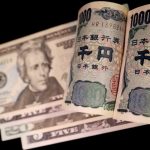
TOKYO (Reuters) – The yen dropped against the dollar on Tuesday, giving up some of its sharp gains the previous day sparked by suspected intervention by Japanese authorities.
The currency was down 0.40% to 157.00 per dollar, but off its 34-year low of 160.245 hit on Monday when traders say yen-buying intervention by Tokyo drove a eye-catching rebound of nearly six yen.
Japanese authorities haven’t confirmed that they had stepped into the currency market in support of the yen, but markets remain on heightened intervention alert ahead of the Federal Reserve’s monetary policy review this week.
Official figures that would reveal whether intervention did in fact occur won’t be available until late May.
While some market players had zeroed in on 160 yen per dollar as the possible trigger for intervention, analysts said Japanese authorities may not be targeting particular levels.
The Japanese currency still sits lower than it was before the Bank of Japan’s (BOJ) policy announcement last week. It has also suffered its largest monthly decline since January.
Investors expect Japanese bond yields will remain low for an extended period. In contrast, U.S. rates are still relatively high and provide enough latitude for yen bears.
“Facing that (the rates divergence) with forex intervention typically does not end well,” said Garvey Padhraic, regional head of research Americas at ING.
“The more obvious solution to this is for Japanese rates to rise. If they don’t, something will have to give. And the bigger the hold-out, the bigger is the subsequent reaction,” he added.
The Fed begins its two-day monetary policy meeting on Tuesday, where it’s expected to hold rates at 5.25%-5.5%, with U.S. inflation proving to be sticky.
It’s also expected to strike a hawkish message, meaning more yen selling is likely, said Carol Kong, a currency strategist at the Commonwealth Bank of Australia (OTC:CMWAY).
“The implication is the MOF will likely be forced to step in more than once to slow the rise in USD/JPY.”
DIVERGENT ECONOMIC OUTLOOKS
While the timing of any possible rate hikes by the BOJ remains vague, traders continue to pare back bets of Fed rate cuts this year amid hotter-than-expected U.S. economic data and stubborn inflation numbers.
A rate cut in September was looking like a close call at just 44%, according to CME Group’s (NASDAQ:CME) FedWatch tool.
The dollar rose to 0.16% to 105.69 against a basket of currencies ahead of the Fed’s meeting, after slipping 0.25% in the previous session.
“Fresh U.S. data has prompted our U.S. economist to push out his projection of the start of the Fed’s easing cycle to 2025 from December 2024,” said Thierry Wizman, global forex and rates strategist at Macquarie.
“We don’t rule out that the next change may be a hike, which would prompt a new wave of broad-based U.S. dollar strength.”
Other major central banks such as the European Central Bank (ECB) and the Bank of England (BoE) may begin to cut rates in the near future, even if the policy path is more uncertain after recent developments.
Euro zone inflation is on its way back to 2%, but the process is bound to be bumpy and geopolitical tensions pose an upside risk to price growth, ECB Vice President Luis de Guindos said late on Monday.
Markets could glean more clues on the timing of ECB’s rate-easing cycle from European inflation data this week due later on Tuesday. Figures from Germany and Spain released on Monday were roughly in line with expectations.
The euro fell 0.17% to $1.0719. Sterling was last trading at $1.2531, down 0.25% on the day.
Elsewhere, a soft retail sales number out of Australia sent the Aussie sliding, last down 0.60% at $0.653, as markets further trimmed the risk of another rate hike by September.
In China, manufacturing and services activity both expanded at a slower pace in April.
The offshore Chinese yuan slipped 0.14% to $7.2523 per dollar. Despite persistent support from the central bank, the yuan has depreciated 2% against the dollar so far this year and is on course for its fourth straight monthly onshore loss.
In cryptocurrencies, bitcoin last rose 0.70% to $63,357.00.
To read the full article, Click Here

